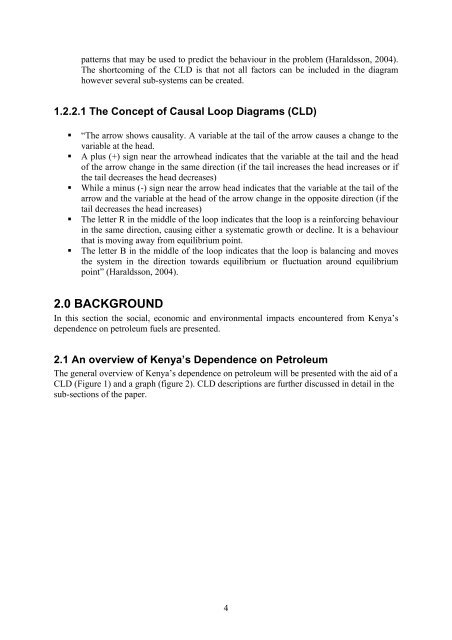ethanol fuel production and use in kenya for sustainable ... - lumes
ethanol fuel production and use in kenya for sustainable ... - lumes
ethanol fuel production and use in kenya for sustainable ... - lumes
You also want an ePaper? Increase the reach of your titles
YUMPU automatically turns print PDFs into web optimized ePapers that Google loves.
patterns that may be <strong>use</strong>d to predict the behaviour <strong>in</strong> the problem (Haraldsson, 2004).The shortcom<strong>in</strong>g of the CLD is that not all factors can be <strong>in</strong>cluded <strong>in</strong> the diagramhowever several sub-systems can be created.1.2.2.1 The Concept of Causal Loop Diagrams (CLD)• “The arrow shows causality. A variable at the tail of the arrow ca<strong>use</strong>s a change to thevariable at the head.• A plus (+) sign near the arrowhead <strong>in</strong>dicates that the variable at the tail <strong>and</strong> the headof the arrow change <strong>in</strong> the same direction (if the tail <strong>in</strong>creases the head <strong>in</strong>creases or ifthe tail decreases the head decreases)• While a m<strong>in</strong>us (-) sign near the arrow head <strong>in</strong>dicates that the variable at the tail of thearrow <strong>and</strong> the variable at the head of the arrow change <strong>in</strong> the opposite direction (if thetail decreases the head <strong>in</strong>creases)• The letter R <strong>in</strong> the middle of the loop <strong>in</strong>dicates that the loop is a re<strong>in</strong><strong>for</strong>c<strong>in</strong>g behaviour<strong>in</strong> the same direction, caus<strong>in</strong>g either a systematic growth or decl<strong>in</strong>e. It is a behaviourthat is mov<strong>in</strong>g away from equilibrium po<strong>in</strong>t.• The letter B <strong>in</strong> the middle of the loop <strong>in</strong>dicates that the loop is balanc<strong>in</strong>g <strong>and</strong> movesthe system <strong>in</strong> the direction towards equilibrium or fluctuation around equilibriumpo<strong>in</strong>t” (Haraldsson, 2004).2.0 BACKGROUNDIn this section the social, economic <strong>and</strong> environmental impacts encountered from Kenya’sdependence on petroleum <strong>fuel</strong>s are presented.2.1 An overview of Kenya’s Dependence on PetroleumThe general overview of Kenya’s dependence on petroleum will be presented with the aid of aCLD (Figure 1) <strong>and</strong> a graph (figure 2). CLD descriptions are further discussed <strong>in</strong> detail <strong>in</strong> thesub-sections of the paper.4
















